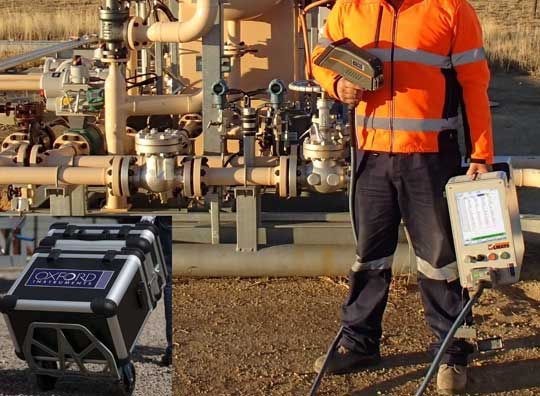LMATS has the capability to perform on site PMI using the latest Portable O.E.S. Optical Emission Spectroscopy inspection and testing methods.
(PMI by Portable Spark spectrometer)
Measure Carbon and Boron in In-situ Steel or Iron parts using Portable O.E.S
Portable Optical Emission Spectrometer (OES) also commonly known as portable spark PMI is battery operated handheld instrument that can be conveniently carried on site and perform chemical analysis of in-situ parts without damaging or reducing the usability of the component. LMATS has multiple units stored at various branch laboratories to meet client demand. Moreover analysis interpretation by LMATS full time employed Metallurgist, Materials engineers.
Despite its portability, it offers high analysis performance and accuracy of test results. Where portable XRF Spectrometer is incapable of determining crucial elements such as C, P, S, Sn, As and B in steel Or Al, Mg, Si in Aluminium alloys; the LMATS Portable Optical Emission Spectrometer (OES) using a special UVTouch probe can measure these elements accurately.
Chemical analysis of the test part can be completed within 5minutes (Average of 3 sparks) after adequate surface preparation. Required surface preparation is essentially bare metal polished to 120grit grinding paper. Analysis spark is protected from atmospheric contamination by using ultra high purity Argon gas.
For general sorting of metals, argon gas is not essential.
Ideal Applications:
- Chemical composition of in-situ steel structures on bridges and plants

- Rapid positive material identification for large number of parts or components used in big pressure vessels and piping in the Petroleum, Chemical and Oil & Gas industry
- Inspection of reinforcing bars, steel slabs and structural parts at the shipping dock
- Requirement for Carbon equivalent of in-service pipeline prior to hot tapping
- Chemical composition of in-situ Aluminium alloys
- Requirements for reverse engineering of in-situ parts
- Correct analysis of small diameter pipes by use of adaptor.
Following elements (including range) can be measured in steel parts.
| ELEMENT | Carbon | Silicon | Manganese | Phosphorous | Sulphur | Chromium | Molybdeum | Nickel |
| % Min | 0.0005 | 0.001 | 0.001 | 0.0005 | 0.0005 | 0.001 | 0.001 | 0.001 |
| % Max | 4.75 | 7 | 20 | 0.8 | 0.4 | 35 | 11 | 52 |
| ELEMENT | Aluminium | Cobolt | Copper | Niobium | Titanium | Vanadium | Tungsten | Zirconium |
| % Min | 0.0005 | 0.0005 | 0.0003 | 0.0005 | 0.0005 | 0.0005 | 0.005 | 0.0005 |
| % Max | 52 | 12 | 9 | 3.3 | 2.3 | 11 | 22 | 0.5 |
| ELEMENT | Arsenic | Tin | Boron | Calcium | Lead | Magnesium | Bismouth | Zinc |
| % Min | 0.0005 | 0.0005 | 0.0005 | 0.0005 | 0.0005 | 0.0005 | 0.0005 | 0.0005 |
| % Max | 0.11 | 0.3 | 0.12 | 0.008 | 0.4 | 0.1 | 0.15 | 0.05 |
| ELEMENT | Nitrogen | Tellurium | Antimony | Cerium | Lanthanium | Selenium | Tantalum | |
| % Min | 0.0025 | 0.0005 | 0.001 | 0.0004 | 0.0005 | 0.0005 | 0.005 | |
| % Max | 1.2 | 0.035 | 0.3 | 0.075 | 0.025 | 0.35 | 0.045 |
Advantages:
- Portable Optical Emission Spectroscopy OES has following advantages over conventional portable XRF
- Carbon & Boron content can be determined in steel and iron parts
- Stainless steel can be classified for 316L or 304L, etc
- Nitrogen content can be measured in Duplex Stainless steel
- Light elements Al, Mg, Si, etc can be accurately measured in Aluminium alloys
- Portable Optical Emission Spectroscopy OES has following advantages over conventional sample collection by grinding/shaving, etc.
- No need to damage in-service big castings, forgings, bridges, structures, pipelines, etc by cutting or extracting samples
- No need to spend hours for sample collection by surface deburring, grinding or shaving on in-situ structures
- Only 10x10mm area needs to be prepared as compared to a need larger area for shaving or grinding
- Sample surface re-coating time reduced by 99%
- Risk of rework (retest) due to sample contamination while shaving or grinding is eliminated
- Portable Optical Emission Spectroscopy OES can be performed on hot or cold surface thus eliminating asset downtime.
Limitations:
- Portable Optical Emission Spectroscopy (OES) is a spark spectroscopy. Hence it will require hot work permit
- Portable Optical Emission Spectroscopy (OES) leaves a thermal burn spot on the test surface. This may not be acceptable on some components
- Portable Optical Emission Spectroscopy (OES) consumes very high purity Argon gas. Hence site permit may be required to carry portable gas bottle on site.
Portable Optical Emission Spectroscopy (OES) FAQ's
Expertise:
Compared to XRF Spectroscopy, Portable Optical Emission Spectroscope (OES) requires extensive training and experience to obtain correct test results. This test method requires highly trained, skilled and experienced materials engineering professionals. LMATS staff are trained and experienced engineers to provide on-site chemical composition of your components.
LMATS offers Portable Optical Emission Spectroscopy (OES) regularly to its clients in VIC - Victoria (Melbourne, Ballarat, Bendigo, Dandenong, Wodonga, Gippsland), NSW - New South Wales (Albury, Wodonga, Sydney, Cooma, Newcastle, Coffs Harbour, Central coast), Qld – Queensland (Brisbane, Gladstone, Chinchilla, Rockhampton, Tasmania) WA – Western Australia (Perth, Bunbary, Collie, Pilbara, Karratha, Esperance, Geraldton, Mandurah, Kalgoorlie, Kambalda, Newman, Olslow), NT - Northern Territory and other states as required by our customers.
To find out more about LMATS Portable Optical Emission Spectroscope (OES) Capabilities simply contact one of the nearest LMATS branch or contact us on +61 3 9399 9199 to get instant information.

